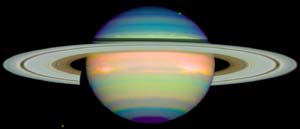Getting closer to the Lord of the Rings

Infrared view of Saturn <br>Credits: Erich Karkoschka (University of Arizona), and NASA
This time next year, ESA’s Huygens spaceprobe will be descending through the atmosphere of Saturn’s largest moon, becoming the first spacecraft to land on a body in the outer Solar System.
Earlier this month, the giant ringed planet Saturn was closer to Earth than it will be for the next thirty years. All the planets orbit the Sun as if on a giant racetrack, travelling in the same direction but in different lanes.
Those in the outer lanes have further to travel than those on the inside lanes. So, Earth regularly ‘laps’ the further planets. On New Year’s Eve 2003, Earth overtook Saturn, drawing closer than at any time in the next three decades.
Through a small telescope, Saturn is normally visible as a creamy yellow ‘star’. You may be able to see the ring system that the planet is famous for, and its largest moon Titan will show up as a tiny dot of light.
That tiny dot is the destination for ESA’s Huygens probe and may hold vital clues about how life began on Earth. Titan is the only moon with a thick atmosphere in the Solar System.
Astronomers think this atmosphere might closely match the one Earth possessed millions of years ago, before life began. Certainly Titan’s atmosphere is rich in carbon, the chemical necessary for life on Earth. What is more, this is all stored in ‘deep freeze’, ten times further from the Sun than the Earth.
The big mystery is Titan’s surface, which is hidden by a cloud layer. This is why ESA built Huygens, to probe through this layer which is impenetrable by Earth-based observations.
In January 2005, Huygens will parachute below the clouds to see what is really going on. Its battery of instruments will return over 1000 images as it floats down and samples the chemistry of this exotic place.
The Titan probe was named Huygens in honour of the Dutch astronomer who discovered Titan in 1655. Launched in October 1997, Huygens is currently in space, hitching a ride on NASA’s Cassini spacecraft.
So look forward to seeing more of Saturn and a tiny European spacecraft called Huygens, that in one year’s time will make an historic landing in the quest to uncover the origins of life.
Media Contact
More Information:
http://www.esa.int/export/esaCP/SEMOGY374OD_index_0.htmlAll latest news from the category: Physics and Astronomy
This area deals with the fundamental laws and building blocks of nature and how they interact, the properties and the behavior of matter, and research into space and time and their structures.
innovations-report provides in-depth reports and articles on subjects such as astrophysics, laser technologies, nuclear, quantum, particle and solid-state physics, nanotechnologies, planetary research and findings (Mars, Venus) and developments related to the Hubble Telescope.
Newest articles

Future AR/VR controllers could be the palm of your hand
Carnegie Mellon University’s EgoTouch creates simple interfaces for virtual and augmented reality. The new generation of augmented and virtual reality controllers may not just fit in the palm of your…

‘Game changer’ in lithium extraction
Rice researchers develop novel electrochemical reactor. A team of Rice University researchers led by Lisa Biswal and Haotian Wang has developed an innovative electrochemical reactor to extract lithium from natural…

The blue-green sustainable proteins of seaweed
… may soon be on your plate. The protein in sea lettuce, a type of seaweed, is a promising complement to both meat and other current alternative protein sources. Seaweed…



